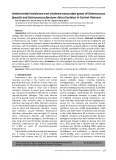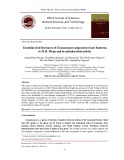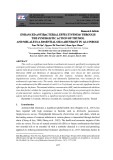Modulation of IMPDH2, survivin, topoisomerase I and vimentin increases sensitivity to methotrexate in HT29 human colon cancer cells Silvia Pen˜ uelas, Ve´ ronique Noe´ and Carlos J. Ciudad
Department of Biochemistry and Molecular Biology, School of Pharmacy, University of Barcelona, Spain
Keywords IMPDH2; methotrexate; survivin; TOP1; vimentin
(IMPDH2),
Correspondence C. J. Ciudad, Departament de Bioquı´mica & Biologia Molecular, Facultat de Farma` cia, Universitat de Barcelona, Av. Diagonal 643, E-08028 Barcelona, Spain Fax: +34 93 402 4520 Tel: +34 93 403 4455 E-mail: cciudad@ub.edu
(Received 3 November 2004, accepted 26 November 2004)
doi:10.1111/j.1742-4658.2004.04504.x
We determined differentially expressed genes in HT29 human colon cancer cells, both after short treatment with methotrexate (MTX) and after the resistance to MTX had been established. Screening was performed using Atlas Human Cancer 1.2K cDNA arrays. The analysis was carried out using Atlas image 2.01 and genespring 6.1 software. Among the differen- tially expressed genes we chose for further validation were inosine mono- phosphate dehydrogenase type II inosine monophosphate cyclohydrolase and survivin as up-regulated genes, and topoisomerase I (TOP1) and vimentin as down-regulated genes. Changes in mRNA levels were validated by quantitative RT-PCR. Additionally, functional analyses were performed inhibiting the products of the selected genes or altering their expression to test if these genes could serve as targets to modify MTX cytotoxicity. Inhibition of IMPDH or TOP1 activity, antisense treatment against survivin, or overexpression of vimentin, sensitized resistant HT29 cells to MTX. Therefore, these proteins could constitute targets to develop modulators in MTX chemotherapy.
folic acid that
Methotrexate (MTX) is a 4-amino 10-methyl analog of inhibits dihydrofolate reductase (DHFR), a key enzyme of the folate cycle and the one carbone unit metabolism [1–3]. MTX was one of the first antimetabolite drugs developed and even now con- tinues to play an important role in the chemotherapy of human malignancies such as acute lymphoblastic leukemia, lymphoma, osteosarcoma, breast cancer, and head and neck cancer [4]. Unfortunately, the efficacy of this chemotherapeutic agent is often compromised by the development of resistance in cancer cells. Typic- ally, MTX resistance is due either to alterations in its to a decreased drug target enzyme, DHFR [5–8], import by the reduced folate carrier [9–12], to an altered polyglutamylation [13,14], or to gene amplifica- tion of the dhfr locus [15,16].
The identification of suitable genes to target in com- bination with MTX could be a strategy to minimize the development of resistance. To this end, we studied the gene expression profile produced upon treatment of cells with MTX, using cDNA arrays that allow the simultaneous evaluation of expression, at the mRNA level, of hundreds of genes. Specifically, the Atlas Human Cancer 1.2K from Clontech(cid:1), a 1176 gene array enriched in genes expressed in cancer and prolif- eration, was used. The human colon adenocarcinoma cell line HT29 was chosen for this study because it can be adapted to grow in high concentrations of MTX [17] and concomitantly develop amplification of the dhfr gene [18]. We used two experimental approaches: (a) to analyze the genes differentially expressed upon short treatment with MTX; and (b) to determine those
FEBS Journal 272 (2005) 696–710 ª 2005 FEBS
696
Abbreviations AICARFT, 5-amino-4-imidazolecarboxamide ribonucleotide formyltransferase; aODN, antisense oligonucleotide; APRT, adenosyl phosphoribosyl transferase; Bcl-2, B-cell leukemia ⁄ lymphoma 2; DHF, dihydrofolate; DHFR, dihidrofolate reductase; GARFT, glycinamide ribonucleotide formyltransferase; IAP, inhibitor of apoptosis protein; IMPCH, inosine monophosphate cyclohydrolase bifunctional enzyme; IMPDH2, inosine monophosphate dehydrogenase type II; MTX, methotrexate; MTT, 3-(4,5-dimethylthiazol-2-yl)-2,5-diphenylterazolium bromide; THF, tetrahydrofolate; TOP1, topoisomerase I.
S. Pen˜ uelas et al. Gene expression in MTX-resistant HT29 cells
genes whose expression is changed in cells with acquired resistance to 10)5 m MTX. The aim of this double strategy was to find out the genes that were dif- ferentially expressed once the resistance had been established and whether their expression had already changed at early stages of the treatment. Then, the effect of modulating these gene products on MTX sen- sitivity was studied.
Results
Analysis of differential gene expression caused by MTX in HT29 cells using cDNA arrays
The expression profile of the 1176 genes included in the Atlas Human Cancer 1.2K Array (Clontech(cid:1)) was analyzed in parental HT29 cells, HT29 cells treated during 24 h with 10)7 m MTX, or HT29-R cells resist- ant to 10)5 m MTX. Cells adapted to 10)5 m MTX presented an enterocyte-like phenotype bearing amplifi- cation of the dhfr locus (10-fold increase) and high lev- els of DHFR protein levels (12-fold increase). Figure 1 shows, as a scatter plot, the distribution of all the genes in the arrays according to their expression, both as a result of a short treatment with a low concentra- tion of MTX and once the resistance had been estab- lished at high concentrations of MTX, with respect to control HT29 cells. We focused our attention on genes that changed their expression in the same direction in both approximations (short treatment with MTX and resistance). For that reason, a cut-off of 1.5-fold was chosen and the differentially expressed genes resulting from the intersection of the two sets were classified according to their function and listed in Table 1.
Fig. 1. Scatter plot, in logarithmic scales, of signal intensities repre- senting the gene expression profiles of parental HT29 cells (A), upon incubation with 10)7 M MTX for 24 h (HT29 treated; B) or resistant to 10)5 M MTX (C). The values are corrected intensities upon normalization and averaging of the replicates of genes present in the Atlas Human Cancer 1.2K cDNA array.
We also found genes implicated in the control of the cell cycle and the process of apoptosis; among them survivin, which was up-regulated. This protein is also involved in tumoral angiogenesis and constitutes a novel anticancer target.
Oncogenes and tumor suppressors were also present in the list of differentially expressed genes. Finally, we selected vimentin as a representative cytoskeleton pro- tein because new functions of these proteins, such as their role in apoptosis, are emerging.
Among the differentially expressed genes there were a number of genes implicated in nucleotide metabolism and DNA synthesis, most likely because MTX inhibits DHFR, an enzyme implicated in these pathways. We paid special attention to the overexpression of inosine monophosphate dehydrogenase type II (IMPDH2), the enzyme that catalyzes the last step in the synthesis of IMP (the GMP and AMP precursor). IMPDH is a target for chemical inhibitors already used in cancer therapy, suggesting the possibility to use them in com- bination with MTX as modulators. Within the same pathway we also found inosine monophosphate cyclo- hydrolase bifunctional enzyme (IMPCH) was overex- pressed, a bifunctional enzyme that catalyzes the two reactions before acting on IMPDH activity. Topoiso- merase I (TOP1) was selected among the underex- pressed genes because of the importance of topology for cell viability and because there are inhibitors avail- able for this enzyme.
Changes in mRNA levels for IMPDH2, IMPCH, sur- vivin, topoisomerase I and vimentin in treated HT29 cells or HT29-R cells were validated by quantitative RT- PCR (Figs 2–6, panel A). The up-regulation of IMP- DH2, IMPCH and survivin and the down-regulation of topoisomerase I and vimentin were confirmed.
FEBS Journal 272 (2005) 696–710 ª 2005 FEBS
697
S. Pen˜ uelas et al. Gene expression in MTX-resistant HT29 cells
Table 1. Differentially expressed genes in HT29 cells treated and resistant to MTX. The table shows the GenBank and SwissProt accession numbers of genes that had their expression up-regulated or down-regulated in both HT29 cells treated with 10)7 M MTX or resistant to 10)5 M MTX. The ratio column corresponds to the expression of each gene relative to the control. Lists of genes were grouped by function. Results are the mean of three independent experiments performed for each condition.
Overexpressed genes in treated and resistant cells Gene name Common Genbank # SwissProt # ratio treated ratio resistant
Apoptosis associated proteins
UBL1 survivin U83117 U75285 Q93068 O15124 2.4 1.9 1.8 2.2 Sentrin Survivin
Cell cycle Stress-activated protein kinase 4 MAPK13 AF004709 O15124 1.7 2.9
Cytoskeleton-motility proteins BCL7B X89985 Q13845 1.6 1.6 B-cell CLL ⁄ lymphoma 7B isoform 1; B-cell CLL ⁄ lymphoma 7B
DNA synthesis, recombination, and repair Proliferating cell nuclear antigen PCNA M15796 P12004 3.9 2.9
Metabolism
Purine nucleoside phosphorylase AICAR formyltransferase ⁄ IMP cyclohydrolase bifunctional enzyme Tymidylate synthetase Glycinamide ribonucleotide formyltransferase Nucleoside-diphosphate kinase Lactate dehydrogenase B Inosine monophosphate dehydrogenase type II Solute carrier family 25 (mitochondrial carrier; NP AICARFT ⁄ IMPCH TYMS GARFT nm23-H4 LDHB IMPDH2 SLC25A5 X00737 U37436 X02308 X54199 Y07604 Y00711 L33842 J02683 P00491 P31939 P04818 P22102 O00746 P07195 P12268 P05141 2.2 1.5 4.8 1.6 1.9 3.8 1.6 2.1 2.3 2.2 1.6 2.8 2.0 6.4 1.6 2.0 adenine nucleotide translocator)
Oncogenes and tumor supressors
FOSL1 NME2 X16707 L16785 P15407 P22392 FOS-like antigen 1 c-myc transcription factor 1.6 2.8 1.9 2.6
Another
Zinc finger transcription factor Interferon-induced protein with tetratricopeptide repeats 1 EGR alpha IFIT1 S81439 X03557 none P09914 3.4 3.0 2.2 2.1
Underexpressed genes in treated and resistant cells Gene name Common Genbank # SwissProt # ratio treated ratio resistant
Apoptosis associated proteins
Retinoid X receptor beta; retinoic acid X receptor b WSL-S2 protein; WSL-S1 protein; WSL-1R protein RXRB TNFRSF12 M84820 Y09392 P28702 Q93038 0.11 0.14 0.30 0.11
Cell cycle pLK E2F-1 Membrane-associated kinase Cyclin C Serine ⁄ threonine protein kinase P53-like transcription factor p19INK4d; p19 protein PLK E2F1 Myt1 CCNC CDK6 P73 CDKN2D U01038 M96577 AF014118 M74091 X66365 Y11416 U40343 P53350 Q01094 O14731 P24863 Q00534 O15350 P55273 0.04 0.14 0.23 0.08 0.01 0.01 0.19 0.50 0.16 0.39 0.08 0.12 0.07 0.12 Cytoskeleton-motility proteins
Growth-arrest-specific protein 2 Vimentin Keratin Keratin 1 GAS2 VIM KRT KRT1 U95032 X56134 J00124 M98776 O43903 P08670 P02533 P04264 0.5 0.43 0.09 0.14 0.18 0.39 0.17 0.10 DNA synthesis, recombination, and repair
FEBS Journal 272 (2005) 696–710 ª 2005 FEBS
698
DNA topoisomerase I Telomerase reverse transcriptase X-ray repair cross complementing protein 1 TOP1 hTRT XRCC1 J03250 AF015950 M36089 P11387 O14746 P18887 0.04 0.20 0.25 0.07 0.03 0.04
S. Pen˜ uelas et al. Gene expression in MTX-resistant HT29 cells
Table 1. (Continued).
Underexpressed genes in treated and resistant cells Gene name Common Genbank # SwissProt # ratio treated ratio resistant
Oncogenes and tumor supressors
mig-5 TIAM1 c-fes Z30183 U16296 X52192 P35625 Q13009 P07332 0.01 0.01 0.06 0.12 0.27 0.25 Tissue inhibitor of metalloproteinase 3 TIAM1 protein V-FES feline sarcoma viral ⁄ V-FPS fujinami avian sarcoma viral oncogene homolog
Pig3 Fibroblast growth factor 5 v-erb-b2 erythroblastic leukemia viral oncogene homolog 3 Small G protein PIG3 FGF5 ERBB3 Gx AF010309 M37825 M29366 M64595 O14679 P12034 P21860 P15153 0.15 0.22 0.19 0.05 0.14 0.02 0.51 0.01
Another
Human tenascin-C; hexabrachion Cadherin 5, type 2 preproprotein; cadherin-5 Cadherin-associated protein-related TNC; HXB VE-cadherin CTNNA2 X78565 X79981 M94151 P24821 P33151 P26232 0.04 0.01 0.08 0.05 0.01 0.03
Functional validation of IMPDH2
survivin whereas 21-mer random and four-nucleotide mismatch oligonucleotides did not show any effect (Fig. 4B) in accordance with previous results [19]. The down-regulation of survivin caused by 0.5 lm aODN- SURV provoked a sensitization to MTX in HT29-R cells because the combination of aODN-SURV with 10)5 m MTX produced an increased cytotoxicity in these resistant cells, more than that produced by aODN-SURV alone (Fig. 4C).
HT29-R cells were incubated with increasing con- centrations of chemical inhibitors of IMPDH acti- vity, benzamide riboside, tiazofurin or mycophenolic in the presence and in the absence of 10)5 m acid, MTX. The three inhibitors produced an increase in the cytotoxicity in combination with the concentra- tion of MTX to which the cells were resistant (Fig. 2B–D).
Functional validation of TOP1
Functional validation of IMPCH
the Down-regulation of TOP1 was confirmed at mRNA and protein levels in treated HT29 and HT29-R cells (Fig. 5A,B). Then, HT29-R cells were incubated with increasing concentrations of the TOP1 in the presence and in the inhibitor, camptothecin, absence of 10)5 m MTX. The cytotoxic effect of camptothecin alone was enhanced by the addition of the concentration of MTX to which the cells were resistant (Fig. 5C).
Functional validation of vimentin
IMPCH was inhibited at the level of mRNA expres- sion using a specific antisense oligonucleotide (aODN) against its translational start (Fig. 3B). The specificity of the aODN effect was tested by determining the mRNA levels of IMPCH after treatment with control antisenses. Either a random oligonucleotide or an unrelated aODN did not cause any effect (Fig. 3B). A dose–response of MTX in combination with 0.5 lm aODN-IMPCH performed in parental HT29 cells revealed that down-regulation of IMPCH reverted the cytotoxicity caused by MTX alone (Fig. 3C). This result was opposite to the expected and for that reason the mRNA levels for DHFR were determined when HT29 cells were treated with aODN-IMPCH. Down- regulation of IMPCH increased DHFR expression (Fig. 3D), thus explaining the desensitization observed toward MTX.
Functional validation of survivin
By Western blot analysis, the decrease in vimentin protein produced by MTX treatment (Fig. 6B) that had already been validated at the level of mRNA by RT-PCR (Fig. 6A), was confirmed. Then, we per- formed transient transfections with an expression vec- tor for vimentin (pcDNA-VIM) in parental HT29 and HT29-R cells in the presence or in the absence of MTX. It can be observed in Fig. 6C that transfection with 1 lg of pcDNA-VIM caused an increase in vimentin protein levels in HT29 cells. The overexpres- sion of vimentin sensitized the cells towards MTX respectively both in parental and resistant
cells,
Targeting of survivin was carried out by lipofecting aODN-SURV in HT29 cells. This antisense oligonucle- otide caused a decrease of 80% in the expression of
FEBS Journal 272 (2005) 696–710 ª 2005 FEBS
699
S. Pen˜ uelas et al. Gene expression in MTX-resistant HT29 cells
Fig. 2. Validation of IMPDH2. (A) The levels of mRNA for IMPDH2 in HT29 cells treated for 24 h with MTX 10)7 M (HT29-T) or resistant to 10)5 M MTX (HT29-R) cells were confirmed by quantitative RT-PCR. One microgram of total RNA was used as the starting material for quan- titative RT-PCR. The quantification of the intensity of the radioactive bands was carried out by phosphorimaging analysis. *P < 0.05 com- pared with the corresponding control situation. (B–D) Dose–response curves for IMPDH inhibitors, benzamide riboside (B), tiazofurin (C), or mycophenolic acid (D), alone and in combination with MTX in HT29-R cells. Cells were exposed to drugs simultaneously, and after 7 days cell viability was determined by the MTT assay and plotted as a percentage of the control (cells not exposed to drugs). IMPDH inhibitor con- centration is shown on the abscissa. The concentrations of MTX were 0 (s) and 10)5 M (d). Results are the mean ± SE obtained from at least three independent experiments.
A
B
C
D
FEBS Journal 272 (2005) 696–710 ª 2005 FEBS
700
Fig. 3. Validation of IMPCH. (A) The levels of mRNA for IMPCH in HT29-T and HT29-R cells were confirmed by quantitative RT-PCR. Other conditions as in Fig. 2. *P < 0.05 compared with the corresponding control situation. (B) Effect on IMPCH mRNA levels by using 0.5 and 1 lM antisense oligonucle- otides against its translational start (aODN- IMPCH) or using 0.5 lM of aODN-21N or aODN-NR. IMPCH mRNA levels were deter- mined 48 h after incubation with the aODNs. (C) Dose–response curves for methotrexate alone (s) or in combination with 0.5 lM of aODN-IMPCH (d), in parental HT29 cells. After 7 days incubation, cell viability was determined and represented as a percent- age of the control. MTX concentration is shown on the abscissa. (D) Effect of target- ing IMPCH on DHFR mRNA levels. Parental HT29 cells were treated with the indicated concentrations of aODN-IMPCH. After 24 h DHFR mRNA levels were determined. Results are the mean ± SE obtained from two independent experiments.
S. Pen˜ uelas et al. Gene expression in MTX-resistant HT29 cells
A
B
C
M MTX in HT29-R cells.
Fig. 4. Validation of survivin. (A) The levels of mRNA for survivin in HT29-T and HT29-R cells were confirmed by quantitative RT-PCR. Other conditions as in Fig. 2. *P < 0.05 and **P < 0.01 compared with the corresponding control situation. (B) Effect of aODN-SURV (21-mer oligonucleotide against survivin), aODN-21N (a 21-mer random oligonucleotide) and aODN-4MIS (21-mer oligonucleotide against survivin including four nucleotide mismaches) on survivin mRNA levels. Parental HT29 cells were treated with the indicated concentrations of aODN- SURV or 0.5 lM of aODN-21 N or aODN-4MIS. After 48 h survivin mRNA levels were determined. (C) Effect of 0.5 lM aODN-SURV treat- ment alone or in combination with 10)5
A
B
C
Fig. 5. Validation of topoisomerase I. The levels of mRNA or protein for topoisomerase I in HT29-T and HT29-R cells were confirmed by quantitative RT-PCR (A) or Western blot (B). Other conditions as in Fig. 2. *P < 0.05 compared with the corresponding control situation. (C) Dose–response curves for camptothecin alone (s), or in combination with 10)5 M MTX (d) in HT29-R cells. After 7 days, cell viability was determined by MTT assay and was plotted as a percentage of the control. Each point represents the mean value for two independent experiments ± SE.
(Fig. 6E,F). We also tested the opposite approxima- tion, that is, down-regulating vimentin in the absence and in the presence of MTX. Targeting of vimentin was carried out by lipofecting aODN-VIM into paren- tal HT29 cells causing a decrease of 60% in the expression of vimentin (Fig. 6D) whereas random or unrelated control oligonucleotides did not show any effect (Fig. 6D). The dose–response of aODN-VIM in the presence or absence of 10)8 m MTX and the dose–response of MTX in the presence or absence of 0.5 lm aODN-VIM demonstrated that down-regula- tion of vimentin by aODN-VIM decreased the cyto- toxicity of MTX in HT29 cells (Fig. 6G,H). The
sensitization to MTX caused by overexpression of vimentin and the decreased cytotoxicity of MTX caused by down-regulation of vimentin were produced together with an increase or a decrease in the apop- totic levels, respectively, in both parental or resistant HT29 cells (Fig. 7A,B). We also determined the levels of apoptosis after transfection of expression plasmids for B-cell leukemia ⁄ lymphoma 2 (Bcl-2) and vimentin in the absence or in the presence of 10)5 m MTX in HT29-R cells. It can be observed that Bcl-2 overexpres- sion decreased the basal apoptotic level and that over- expression of vimentin reversed the effect of Bcl-2 (Fig. 7C).
FEBS Journal 272 (2005) 696–710 ª 2005 FEBS
701
S. Pen˜ uelas et al. Gene expression in MTX-resistant HT29 cells
A
B
C
D
E
F
M MTX and HT29- M MTX. (G) Dose–resp-
M of MTX (d) in par-
G
H
Fig. 6. Validation of vimentin. The levels of mRNA and protein for vimentin in HT29-T and HT29-R cells were confirmed by quanti- tative RT-PCR (A) or Western blot (B). *P < 0.05 compared with the corresponding control situation. (C) Effect of 1 lg pcDNA- VIM transfection on vimentin protein levels in HT29 parental cells. (D) Effect of aODN- VIM (21-mer oligonucleotide against vimentin), aODN-21N (a 21-mer random oligonucleotide) and aODN-NR (aODN against a nonrelated gene) on vimentin mRNA levels. Parental HT29 cells were trea- ted with 0.5 lM of aODN-VIM for 24 or 48 h or with 0.5 lM of aODN-21 N or aODN-NR during 48 h. (E,F) Sensitization to MTX by overexpressing vimentin. The indicated amounts of pcDNA-VIM were transiently transfected and incubated in the absence or presence of MTX. Parental HT29 cells (E) were incubated with 10)8 R cells (F) with 10)5 onse curves for aODN-VIM alone (s) or in combination with 10)8 ental HT29 cells. After 7 days incubation, cell viability was determined and represen- ted as a percentage of the control. (H) Dose–response curves for methotrexate alone (s) or in combination with 0.5 lM of aODN-VIM (d) in parental HT29 cells. After 7 days incubation, cell viability was deter- mined. MTX concentration is shown on the abscissa. Results are the mean ± SE obtain- ed from at least two independent experiments.
for
combinational
Discussion
for
type of
The aim of this study was to identify differentially expressed genes as a result of MTX treatment to therapy. We this design modulators focused our attention onto genes that changed their expression after an initial short incubation of parental cells with MTX and also once the cells had acquired resistance to high concentrations of the drug. Presum- ably, those genes may participate in the mechanism to develop resistance and, thus, constitute suitable tar-
therapy with MTX. The gets expression analyses were performed using specific can- cer cDNA arrays containing 1176 gene cDNAs. Even though this number might seem limited considering the total number of coding genes in the human gen- ome, it has to be stated that this array is specifically designed to contain cDNAs related to proliferation and cancer. Selected genes were validated by quantita- tive RT-PCR and their involvement in MTX-sensitiv- ity was tested in functional analyses. Some genes might have changed their expression associated with
FEBS Journal 272 (2005) 696–710 ª 2005 FEBS
702
M of MTX in parental HT29 cells (A) or 10)5
S. Pen˜ uelas et al. Gene expression in MTX-resistant HT29 cells
Fig. 7. Changes in apoptosis caused by overexpressing or targeting vimentin. (A,B) One microgram of pcDNA-VIM or 0.5 lM aODN-VIM were lipofected either in the absence or in the presence of 10)8 M of MTX in HT29-R cells (B). Twenty-four hours after MTX treatment propidium iodide-negative, annexin V-FITC-positive cells were taken as the apoptotic population. *P < 0.05 with respect to control cells. (C) Propidium iodide-negative, annexin V-FITC-positive cells were determined in HT29-R after trans- fection of 1 lg pSFFV-Bcl2 and 1 lg pcDNA-VIM, each one alone or together. The same conditions were determined in the presence of 10)5 M of MTX. Results are the mean ± SE obtained from eight values. *P < 0.05 with respect to control cells. #P < 0.05 with respect to cells with Bcl-2 overexpressed.
IMPDH activity in DNA synthesis, which was increased when combining them with MTX. There- fore, by decreasing the activity of the overexpressed gene IMPDH2 in HT29-R cells, we were able to sen- sitize the resistant cells to MTX, thus showing the modulator effect of IMPDH inhibitors.
the chemotherapeutic treatment, whereas a different set of genes could modify their expression in order to the primary changes pro- compensate for some of duced by the chemotherapeutical agent to allow the cells to survive. However, it is possible to discern the type of response of each gene by modifying their expression and testing how this modification affects MTX cytotoxicity. As tools we used chemical inhibi- tors of determined gene products, aODNs to decrease the expression of specific genes and expression vectors of selected genes.
As IMPCH expression was also increased, and given that this RNA encodes the bifunctional enzyme ATIC [5-amino-4-imidazolecarboxamide ribonucleotide for- myltransferase (AICARFT) ⁄ inosine monophosphate cyclohydrolase (IMPCH)] we used an aODN to reduce the expression of both activities. This bifunctional enzyme catalyzes the penultimate and final steps in the de novo purine nucleotide biosynthetic pathway using N10-formyltetrahydrofolate as a reduced folate cofactor. However, in spite of that aODN-IMPCH decreased IMPCH mRNA levels (Fig. 3B); when com- bined with MTX, the cytotoxicity caused by MTX partially reverted. This effect could be explained by the observation that when IMPCH mRNA levels were decreased by aODN-IMPCH, DHFR RNA expression was increased. It is known that when DHFR activity is abolished, tetrahydrofolate (THF)-cofactors rapidly interconvert to 5,10,methylene-tetrahydrofolate which, in turn, is rapidly oxidized to dihydrofolate (DHF) [23]. This is followed by a rapid decrease in THF- cofactors that, while often incomplete, is associated with the cessation of THF-cofactor-dependent reac- tions within a few minutes [24,25]. Thus, overexpres- sion of IMPCH upon MTX treatment could represent
The first gene subjected to functional validation was IMPDH2, which actively catalyzes the step from IMP to XMP and is the rate-limiting step in the de novo synthesis of guanylates, including GTP and dGTP [20], and is thus required for DNA synthesis. In this regard the increased expression of IMPDH2 could be interpreted as a way to compensate for the inhibition of DHFR by MTX as both enzymes are IMPDH in the same pathway. Two isoforms of have been demonstrated. IMPDH type I enzyme is constitutively expressed in normal cells, whereas the IMPDH type II is significantly up-regulated in malig- nant cells [21,22]. Benzamide riboside, tiazofurine and mycophenolic acid are potent inhibitors of this enzy- mic activity and phase II ⁄ III clinical trials that have been conducted with them as anticancer drugs in patients with leukemias have shown very promising results. These inhibitors presented a degree of cyto- toxicity by themselves, according to the role of
FEBS Journal 272 (2005) 696–710 ª 2005 FEBS
703
S. Pen˜ uelas et al. Gene expression in MTX-resistant HT29 cells
thymidylate
pyrimidine
synthesis:
a reaction of the cell to compensate the depletion in reduced folate cofactors. Similarly, DHFR overexpres- sion caused by IMPCH targeting could be explained by an attempt of the cell to compensate the low IMP- CH activity with a surplus of reduced folates. The high regulation shown by the enzymes that use THF-cofac- tors indicates that an improved therapy would involve a multitargeted antifolate. Indeed, a novel inhibitor, inhibits at least pemetrexed, now in phase II trials, four enzymes involved in folate metabolism and purine and synthase, DHFR, glycinamide ribonucleotide formyltransferase (GARFT) and AICARFT [26]. It is worth mentioning that the RNAs for GARFT and thymidylate synthase are also increased in the arrays from cells treated with MTX or HT29-R. Overexpression of GARFT in trea- ted and resistant cells was also validated by RT-PCR (data not shown). Thus, the increases in GARFT and AICARFT expression could be as a result of the inhibition of these two enzymatic activities by MTX polyglutamates [27].
cells are characterized by high levels of TOP1 activity [39,40], this enzyme has become one of the cellular tar- gets for anticancer therapy [41,42]. TOP1 is inhibited by the camptothecin family of anticancer compounds, which act by stabilizing the covalent protein–DNA complex and enhancing apoptosis through blocking the advancement of replication forks. We took advant- age of the down-regulation of TOP1 in MTX-resist- ance as a way to increase the sensitivity to MTX. Indeed, by combining MTX and camptothecin, a higher degree of cytotoxicity than with camptothecin alone was achieved in HT29-R. This illustrates a stra- tegy for cancer therapy based on using as a modulator an inhibitor of a gene product that it is already under- expressed as a result of the resistance stage toward the primary chemotherapy agent. A possible explanation for the increased cytotoxicity of the combination of MTX plus camptothecin could be based on the obser- vations that treatment with camptothecin, after an ini- tial apoptotic signal, activates nuclear factor j-B resulting in the expression of genes that have an over- all antiapoptotic effect, leading to camptothecin resist- ance [43]; and that MTX counteracts the binding of nuclear factor j-B activated by apoptotic stimuli, thus increasing apoptosis [44].
that
product
cleavage
Survivin is a member of the inhibitor of apoptosis protein (IAP) family [28] which directly inhibits caspase-3, -7 [29–31], and caspase-9 activities [32,33]. Moreover, survivin indirectly inhibits caspase activity by promoting procaspase-3–p21 complex formation as a result of an interaction with cyclin-dependent kinase 4 [34] and by sequestering direct-IAP binding protein (Smac ⁄ DIABLO), thus preventing Smac ⁄ DIABLO binding to other IAPs [35]. Survivin is lar- gely undetectable in normally differentiated adult tis- sues but, in contrast, it is dramatically overexpressed in most human tumors, thus conferring growth and survival advantages for tumor onset and progression [36]. The observation that survivin expression is increased in HT29 cells treated with MTX is in keep- ing with the antiapoptotic role of this protein, and would contribute to counteract the apoptosis caused by MTX. Interestingly, survivin is also overexpressed in endothelial cells of newly formed blood vessels found in tumors [37,38]. Therefore, down-regulation or inhibition of survivin could be considered as an attractive strategy in cancer therapy. We used the antitranslational aODN-SURV [19] to decrease the overexpression of survivin caused upon MTX treat- ment, observing that the combination of this aODN plus MTX sensitized the cells towards this drug in HT29-R cells.
Finally, we also observed that treatment with MTX leads to an underexpression of the cytoskeleton pro- tein vimentin, an abundant type III intermediate fil- ament protein, which is cleaved by caspases-3, -7 and -6 during apoptosis [45]. The proteolysis of vimentin promotes apoptosis by dismantling intermediate fila- ments and by generating a proapoptotic amino- terminal interferes with intermediate filament assembly [45]. On the other hand, it has been reported that Bcl-2, which has an antiapoptotic effect, inhibits caspase-3 and the proteo- lysis of vimentin [46]. Previous reports positivity linked vimentin to more agressive tumor characteristics [47] contributing to the invasive phenotype, but cannot confer it alone [48]. However, a decreased expression of vimentin has been reported in ERBB2 oncogene (HER2) overexpressing breast cancer tumors that are known to be refractory to various types of chemother- apy [49]. Also in breast cancer, either low [50] or high [51] expression of vimentin has been described in tum- ors that underexpressed the estrogen receptor (poor prognostic indicator). Vimentin expression has also been considered as a marker of resistance in doxorubi- cin-resistant LoVo cells [52] and in the multidrug resistant MCF7 subline [53], but parental cells trans- fected with human vimentin cDNA, did not become resistant. It is interesting to note that, in addition to the decrease of vimentin expression, MTX-resistant
Human TOP1 is a nuclear protein that relaxes superhelical tension associated with DNA replication, transcription and recombination by reversibly nicking one strand of duplex DNA and forming a covalent 3¢-phosphotyrosine linkage. Because many neoplastic
FEBS Journal 272 (2005) 696–710 ª 2005 FEBS
704
S. Pen˜ uelas et al. Gene expression in MTX-resistant HT29 cells
HT29 cells show enhanced synthesis and secretion of mucin 1 transmembrane (MUC1) [54], which has been linked to tumor aggressiveness. Conversely, low levels of MUC1 expression were associated with increased expression of vimentin [55], suggesting an inverse rela- tionship between vimentin and MUC1. Mimicking the down-regulation of vimentin by aODN a decrease in MTX sensitivity was observed, while overexpression of vimentin turned parental and resistant HT29 cells sen- sitive to MTX. These changes in MTX sensitivity were also reflected in the apoptotic levels. On one hand, overexpression of vimentin counteracts the antiapop- leading to an increase in the totic effect of Bcl-2, apoptotic levels caused by MTX in resistant cells, and on the other hand, down-regulation of vimentin leads to a decrease in apoptosis, which is a well known mechanism of resistance.
to screen for genes
in
products
gene
that
are
cDNA arrays was prepared using the AtlasTM pure total RNA Labeling kit (Clontech) from 4 · 106 cells, either parental HT29, HT29 treated with 10)7 m MTX for 24 h, or HT29-R. RNA was treated with RNAse-free DNAse (10 U per 50 lg of RNA) at 37(cid:2) for 30 min. The integrity of the RNA was assessed after agarose gel electrophoresis in the presence of formaldehyde. Radiolabeled cDNA probes were prepared from 5 lg of total RNA. Briefly, RNA was hybridized for 2 min at 70 (cid:2)C followed by 2 min at 50 (cid:2)C with 1 lL of the primer mix, containing only the 1176 primers for the genes present in the array, thus confer- ring a 10-fold increase in sensitivity and a concomitant reduction in nonspecific background. The reverse transcrip- tion reaction was carried out using 100 U MMLV RT, 40 U rRNasin(cid:1) (Promega, Madison, WI, USA) and 30 lCi of [32P]dATP[lP] (Amersham Bioscience, Freiburg, Ger- many) for 25 min at 50 (cid:2)C. After filtering the unincorporat- ed nucleotide through Sephadex G-50 columns, membrane hybridizations were carried out. Nylon filters were prehy- 5 mL ExpressHybTM (Clontech) with bridized 100 lgÆmL)1 DNA salmon sperm for 30 min in roller bot- tles with continuous agitation in an oven at 68 (cid:2)C. Then, the 32P-labelled probe was added and hybridization contin- ued overnight in the same conditions. Afterwards, mem- branes were washed four times, lowering the astringency progressively to 0.5· NaCl ⁄ Cit, 0.5% SDS at 65 (cid:2)C and placed in contact with europium screens (Kodak, Roche- ster, NY, USA) for 7 days and scanned with a Storm 840 phosphorimager (Molecular Dynamics, Sunnyvale, CA, USA).
Array data analysis
In summary, we performed a study using cDNA that are differentially arrays expressed upon short treatment with MTX and in cells resistant to this drug. We sought to modulate methotrexate therapy using either (a) chemical inhibi- tors against gene products that are overexpressed (such as IMPDH2); (b) antisense oligonucleotides that reverted the up-regulation of genes that increased their expression (like IMPCH and survivin); (c) chemical inhibitors that are already used as anticancer drugs against underexpressed (TOP1); or (d) expression vectors for gene products that are underexpressed (vimentin). The functional targets defined in this study could contribute to the development of new therapeutic protocols in combina- tions with MTX.
Experimental procedures
Cell culture
the median of
the control
line HT29 were rou- Human colon adenocarcinoma cell tinely grown in Ham’s F12 selective DHFR medium (–GHT medium) lacking glycine, hypoxanthine and thymi- dine, the final products of DHFR activity. This medium was supplemented with 7% dialyzed fetal bovine serum (Gibco, Paisley, UK) at 37 (cid:2)C in a 5% CO2 humidified atmosphere. Resistant cells 10)5 m MTX (HT29-R) were obtained upon incubation with stepwise concentrations of MTX (Lederle, Madrid, Spain).
cDNA arrays
Image analysis and quantification were carried out with Atlas image 2.0.1. After grid assignment the adjusted intensity for each gene was calculated by subtracting the background. This value was used as the input for the genespring 6.1 program (Silicon Genetics, Redwood City, CA, USA), which allows multifilter comparisons using data from different experiments to perform the normali- zation, generation of restriction lists and the functional classification of the differentially expressed genes. Normal- ization was applied in two steps: (a) ‘per chip normaliza- tion’ in which each measurement was divided by the 50th percentile of all measurements in its array; and (b) ‘per gene normalization’ in which all the samples were normal- ized against samples. The expression of each gene is reported as the ratio of the value obtained after each condition relative to control conditions after normalization of the data. Then data were filtered using the control strength, a control value calcula- ted using the Cross-Gene Error Model based on replicates [56]. Measurements with higher control strength are relat- ively more precise than measurements with lower control
Gene expression was analyzed by hybridization to cDNA arrays (AtlasTM Human Cancer Array 1.2K from Clontech Laboratories Inc., Palo Alto, CA, USA). Total RNA for
FEBS Journal 272 (2005) 696–710 ª 2005 FEBS
705
random hexamers
total RNA, 125 ng of
strength. Genes that didn’t reach this value were discar- ded. Lists of differentially expressed genes considering a 1.5-fold expression were generated using data from at least three independent experiments for each condition. The genes in these lists were further classified according to their function.
S. Pen˜ uelas et al. Gene expression in MTX-resistant HT29 cells
Determination of the dhfr copy number
HT29 or HT29-R cells (10 000) were centrifuged at 10 000 g for 5 min and the cell pellet was washed once with ice-cold NaCl ⁄ Pi. The cells were centrifuged again at 10 000 g for 5 min, and after discarding the supernatant, resuspended in 20 lL lysis buffer (20 mm NaCl, 1 mm EDTA, 0.1% SDS, and 50 mm Tris ⁄ HCl, pH 8) plus 2 lL of 10 mgÆmL)1 proteinase K. They were then incubated at 55 (cid:2)C for 15 min, vortexed vigorously and incubated for 15 min at the same temperature. Finally, the mixture was incubated at 100 (cid:2)C for 5 min and, after cooling, 1 lL was used for PCR amplification [57]. The primers used for dhfr amplification were: 5¢-CCTGTTAACGCAGTGTTTCTC-3¢ within intron 1 and 5¢-TCCCACGGGAGACTTCGCACT- 3¢ within intron 2. For adenosyl phosphoribosyl transferase (aprt) the oligonucleotides were: 5¢-TCACGAGCCAG CAAGGCGTT-3¢ within intron 1 and 5¢-ACGCAGTACT CATCCAGGGT-3¢ within intron 2.
a total volume of 20 lL from RNA samples by mixing 1 lg of (Roche, Mannheim, Germany), in the presence of 75 mm KCl, 3 mm MgCl2, 10 mm dithiothreitol, 20 U RNasin (Promega), 0.5 mm dNTPs (AppliChem, Darmstedt, Germany), 200 U M-MLV reverse transcriptase (BRL-Gibco, Paisley, UK) and 50 mm Tris ⁄ HCl buffer, pH 8.3. The reaction mixture was incubated at 37 (cid:2)C for 60 min and the cDNA product was used for subsequent PCR amplification with specific primers. A standard 50 lL mixture contained 5 lL of the cDNA mixture, 1.2 mm MgCl2, 0.2 mm dNTPs, 2.5 lCi of [32P]dATP[aP] (3000 CiÆmmol)1, Amersham Ibe´ rica, Madrid, Spain), 1.5 U Taq polymerase (Ecogen, Barcelona, Spain) and 500 ng of each primer, and 20 mm Tris ⁄ HCl, pH 8.5. To avoid unspecific annealing, cDNA and Taq DNA polymerase were separated from primers and dNTPs by using a layer of paraffin (Fluka, Basel, Switzerland) (reaction components contact only when paraffin fuses, at 60 (cid:2)C). PCR was per- formed in an MJ Research (South San Francisco, CA, USA) thermocycler equipped with peltier system and temperature probe. Preliminary experiments were carried out using differ- ent numbers of cycles to determine the linear conditions of PCR amplification for all the genes studied. The sequences of the forward and reverse primers used for PCR amplification, the length of the PCR product, the number of cycles used in the PCR, and the linear range for the amplification are given in Table 2.
The dhfr copy number was calculated according to the ratio of the dhfr and aprt signals for each MTX-resistant clone.
RT-PCR
[32P]dATP[aP] was used in the PCR to produce a radio- active product that could be detected with great sensitivity during the exponential phase of the reaction. After an ini- tial denaturation for 1 min and 30 s at 94 (cid:2)C, PCR was performed for the indicated number of cycles. Each cycle consisted of denaturation at 92 (cid:2)C for 1 min, primer annealing at 59 (cid:2)C, and primer extension at 72 (cid:2)C for 1 min. A final 5-min extension step at 72 (cid:2)C was per- formed. Five microliters of each PCR sample was electro- phoresed on a 1-mm-thick 5% polyacrylamide gel. The gels
Levels of specific mRNAs were determined by RT-PCR under quantitative conditions. Total RNA was extracted from cells (4 · 106) using UltraspecTM RNA reagent (Bio- tecx, Houston, TX, USA) following the recommendations of the manufacturer. Complementary DNA was synthesized in
Table 2. Sequences of the forward and reverse primers used for PCR amplification, the length of the PCR product, the number of cycles used in the PCR, and the linear range for the amplification.
Gene Product length (bp) Number of cycles Linear cycle range Primer sequence (5¢ to 3¢)
480 IMPDH2 26 24–28
359 IMPCH 23 21–26
165 SURV 27 23–29
333 TOP1 24 21–25
373 VIM 26 22–28
FEBS Journal 272 (2005) 696–710 ª 2005 FEBS
706
253 APRT 20 19–25 for: 5¢-AACCTCATTGATGCAGGTGTG-3¢ rev: 5¢-AATGTCCTGGCATGAGTGTTG-3¢ for: 5¢-ACTCCTTGGAGACTAGACGC-3¢ rev: 5¢-TTTGGCCTCATCTTCACTGAG-3¢ for: 5¢-GGACCGCCTAAGAGGGCGTGC-3¢ rev: 5¢-AATGTAGAGATGCGGTGGTCC-3¢ for: 5¢-CAAGCAGCCCGAGGATGATC-3¢ rev: 5¢-GCACTTTTCAGGTCTCTCCG-3¢ for: 5¢-GGCTCAGATTCAGGAACAGC-3¢ rev: 5¢-CTGAATCTCATCCTGCAGGC-3¢ for: 5¢-GCAGCTGGTTGAGCAGCGGAT-3¢ rev: 5¢-AGAGTGGGGCCTGGCAGCTTC-3¢
S. Pen˜ uelas et al. Gene expression in MTX-resistant HT29 cells
Functional validation by transfecting expression plasmids of the gene target
were dried and placed on contact with europium screens that were scanned using phosphorimaging. The expression of specific mRNAs is reported upon normalization using the APRT mRNA as the internal control.
Total extracts and Western blots
fluoride,
1 mm phenylmethanesulfonyl
HT29 or HT29-R cells were seeded into 6-well plates at a density of 105 cellsÆwell)1 in 2 mL of Ham’s F12 selective medium. Eighteen hours later, transfections with an expres- sion plasmid for vimentin (pcDNA3-VIM) (RM Evans, University of Colorado, Denver, CO, USA) in the presence or absence of MTX were performed. For each well, 3 lL of FuGENE6 (Roche Molecular Biochemicals) in 100 lL of serum free –GHT medium was incubated at room tempera- ture for 5 min. Then, this mixture was added to the DNA and, after 15 min at room temperature, added to the cells. When combining pcDNA-VIM transfection and MTX treatment, MTX was added at the same time of the trans- fection. The effect of FuGENE in MTX effectiveness was assessed with the corresponding controls. Seven days later, the viability was measured by the MTT assay. The level of apoptosis was determined 24 h after MTX treatment as described below. Overexpression of Bcl-2 was achieved by transient transfection of 1 lg pSFFV-Bcl2 (P Perego, Insti- tuto Nazionale Tumori, Milan, Italy). In the experiments of cotransfection with Bcl-2 and vimentin, the expression plas- mids were transfected simultaneously.
Functional validation by transfecting aODNs against the target RNAs
Whole extracts were obtained from HT29 or HT29-R cells following the method of Kraus et al. [58]. Cells were collec- ted in ice-cold F12 medium and centrifuged at 1000 g for 5 min. The cell pellet was gently resuspended in 5 mL of (15 mm NaCl, 60 mm KCl, 0.5 mm hypotonic buffer 1 mm EDTA, 2-mercaptoethanol, 15 mm Tris ⁄ HCl, pH 8). After centrifu- gation in the same conditions as above, the pellet was resuspended in 100 lL of a buffer containing deoxycholate [100 mm NaCl, 10 mm NaH2PO4 (pH 7.4), 0.5% (w ⁄ v) sodium deoxycholate, 0.1% (w ⁄ v) SDS, 1% (v ⁄ v) Triton X- 100] and centrifuged at 13 000 g for 10 min. The resulting supernatant corresponded to the whole extract. The entire procedure was carried out at 4 (cid:2)C. Five microliters of the extract was used to determine the protein concentration by the Bradford assay (Bio-Rad, Madrid, Spain). The extracts were frozen in liquid N2 and stored at )80 (cid:2)C. One hun- dred micrograms of total extracts from cells was resolved on SDS polyacrylamide gels (12% for DHFR; 10% for [59] and transferred to vimentin and 7% for TOP1) poly(vinylidene diflouride) membranes (Immobilon P, Milli- pore, Billerica, MA, USA) using a semidry electroblotter. The membranes were probed with antibodies against DHFR [60] to determine the levels of DHFR protein due to gene amplification in HT29-R cells, and with antibodies against vimentin or TOP1 (both from Santa Cruz Biotech- nology, Santa Cruz, CA, USA) when validating these tar- gets. Signals were detected by secondary horseradish peroxidase-conjugated antibody and enhanced chemilumi- niscence, as recommended by the manufacturer (Amer- sham). To normalize the results, blots were reprobed with antibodies against actin (for DHFR) or Oct-1 (for vimentin and TOP1).
Functional validations using chemical inhibitors of the gene target
HT29 or HT29-R cells (2.5 · 104) were plated in 35-mm wells in 1 mL of –GHT medium. Two hours later, antisense oligonucleotides were delivered to cells in the form of com- plexes with the transfection reagent DOTAP(cid:1) (Roche), in the presence or absence of MTX. Previously, the oligonu- cleotides and the liposome were mixed in Eppendorf tubes at room temperature for 15 min at a 1 : 10 molar ratio (DNA ⁄ DOTAP(cid:1)) as described previously [62]. Then the mixture and MTX were added simultaneously to the cell culture and cells were incubated for 24 h before apoptotic levels were determined, or for seven days before the MTT assays were performed. Oligonucleotides aODN-IMPCH, aODN-SURV and aODN-VIM, were directed against nucleotides 1–21 relative to the translational start site of the IMPCH, survivin and vimentin RNAs, respectively. the antisense oligonucleotides were: The sequences of aODN-IMPCH, 5¢-T*A*A*GGC*TGAGAGAGAAGA* C*A*T-3¢; aODN-SURV, 5¢-G*G*G*CAACG*T*C*GG GGCAC*C*C*A*T-3¢; aODN-VIM, 5¢-G*G*A*CAC*GG AC*C*T*GGT*GGA*C*A*T-3¢.
Specific bonds
(marked with an asterisk) contained phosphorothioate modifications the aODNs to render (Sigma) more resistant to the nucleases. To check for specificity, three types of control oligonucleotides were (a) an unrelated aODN (aODN-NR) directed used: against the translational start of the livin mRNA, (b) a (aODN-21 N) and (c) a four-nucleo- random 21-mer
Twenty-five thousand HT29-R cells were seeded in 35-mm diameter wells in –GHT medium. Cells were cultured for 18 h without treatment and then incubated with different IMPDH inhibitors, benzamide riboside, tiazofurine, myco- phenolic acid, supplied by H Jayaram (IUPUI, Indianapolis, IN, USA), or the TOP1 inhibitor camptothecin (Sigma, Madrid, Spain), in the presence or absence of MTX. IMPDH activity inhibitors were added simultaneously to MTX. Camptothecin, was added 24 h after MTX. After 7 days the 3-(4,5-dimethylthiazol-2-yl)-2,5-diphenylterazolium bromide (MTT) test [61] was performed to determine cell viability.
FEBS Journal 272 (2005) 696–710 ª 2005 FEBS
707
contributes to antifolate resistance in Chinese hamster cells. Cancer Res 53, 6031–6035.
(aODN-4MIS): aODN- tide mismatch oligonucleotide NR, 5¢-G*G*C*AC*TGT*CT*T*TAGGT*C*C*C*A*T-3¢; aODN-4MIS, 5¢-G*G*G*CAACG*T*C*GC*C*C*GAC* C*C*A*T-3¢.
S. Pen˜ uelas et al. Gene expression in MTX-resistant HT29 cells
Apoptosis assays
8 Srimatkandada S, Schweitzer BI, Moroson BA, Dube S & Bertino JR (1989) Amplification of a polymorphic dihydrofolate reductase gene expressing an enzyme with decreased binding to methotrexate in a human colon carcinoma cell line, HCT-8R4, resistant to this drug. J Biol Chem 264, 3524–3528.
9 Dixon KH, Lanpher BC, Chiu J, Kelley K & Cowan
KH (1994) A novel cDNA restores reduced folate car- rier activity and methotrexate sensitivity to transport deficient cells. J Biol Chem 269, 17–20.
Apoptosis was assessed by annexin V-FITC (Bender Med- Systems, Vienna, Austria) binding. Twenty-four hours after MTX treatment, floating and adherent cells were collected, washed in NaCl ⁄ Pi and resuspended in annexin-binding buf- fer. Cells were collected, washed in NaCl ⁄ Pi and resuspended in binding buffer containing a final concentration of 0.5 lgÆmL)1 annexin V-FITC and incubated at room tem- perature for 1 h in the dark. Afterwards, cells were centri- fuged at 800 g 5 min and resuspended in annexin-binding buffer containing propidium iodide (Sigma) at 1 lgÆmL)1. After 15 min of incubation, cells were analyzed with an EPICS-XL flow cytometer (Coulter Corp., Miami, FL, USA). Propidium iodide-negative, annexin V-FITC-positive cells were taken as the apoptotic population.
Acknowledgements
10 Jansen G, Mauritz R, Drori S, Sprecher H, Kathmann I, Bunni M, Priest DG, Noordhuis P, Schornagel JH, Pinedo HM, Peters GJ & Assaraf YG (1998) A structu- rally altered human reduced folate carrier with increased folic acid transport mediates a novel mechanism of antifolate resistance. J Biol Chem 273, 30189–30198. 11 Roy K, Tolner B, Chiao JH & Sirotnak FM (1998) A single amino acid difference within the folate transpor- ter encoded by the murine RFC-1 gene selectively alters its interaction with folate analogues. Implications for intrinsic antifolate resistance and directional orientation of the transporter within the plasma membrane of tumor cells. J Biol Chem 273, 2526–2531.
This work was supported by grants 2002SAF-0363 from Comisio´ n Interministerial de Ciencia y Tecnolo- gia and 2001SGR-0141 from Generalitat de Catalunya. S.P. was a recipient of a fellowship from the Ministerio de Ciencia y Tecnologı´ a (MCYT).
References
1 Huennekens FM (1994) The methotrexate story: a para-
digm for development of cancer chemotherapeutic agents. Adv Enzyme Regul 34, 397–419.
12 Zhao R, Sharina IG & Goldman ID (1999) Pattern of mutations that results in loss of reduced folate carrier function under antifolate selective pressure augmented by chemical mutagenesis. Mol Pharmacol 56, 68–76. 13 Roy K, Egan MG, Sirlin S & Sirotnak FM (1997) Post- transcriptionally mediated decreases in folylpolygluta- mate synthetase gene expression in some folate analogue-resistant variants of the L1210 cell. Evidence for an altered cognate mRNA in the variants affecting the rate of de novo synthesis of the enzyme. J Biol Chem 272, 6903–6908.
2 Goldman ID & Matherly LH (1985) The cellular phar- macology of methotrexate. Pharmacol Ther 28, 77–102.
3 Wagner C (1996) Symposium on the subcellular com-
14 Rhee MS, Wang Y, Nair MG & Galivan J (1993) Acquisition of resistance to antifolates caused by enhanced gamma-glutamyl hydrolase activity. Cancer Res 53, 2227–2230.
partmentation of folate metabolism. J Nutr 126, 1228S– 1234S.
15 Curt GA, Cowan KH & Chabner BA (1984) Gene
amplification in drug resistance: of mice and men. J Clin Oncol 2, 62–64.
4 Chu E, Grem JL, Johnston PG & Allegra CJ (1996) New concepts for the development and use of anti- folates. Stem Cells 14, 41–46.
16 Carman MD, Schornagel JH, Rivest RS, Srimatkand-
5 Alt FW, Kellems RE, Bertino JR & Schimke RT (1978) Selective multiplication of dihydrofolate reductase genes in methotrexate-resistant variants of cultured murine cells. J Biol Chem 253, 1357–1370.
6 Dicker AP, Volkenandt M, Schweitzer BI, Banerjee D & Bertino JR (1990) Identification and characterization of a mutation in the dihydrofolate reductase gene from the methotrexate-resistant Chinese hamster ovary cell line Pro-3 MtxRIII. J Biol Chem 265, 8317–8321.
ada S, Portlock CS, Duffy T & Bertino JR (1984) Resis- tance to methotrexate due to gene amplification in a patient with acute leukemia. J Clin Oncol 2, 16–20. 17 de Nonancourt-Didion M, Gueant JL, Adjalla C, Chery C, Hatier R & Namour F (2001) Overexpression of folate binding protein alpha is one of the mechanism explaining the adaptation of HT29 cells to high concen- tration of methotrexate. Cancer Lett 171, 139–145. 18 Lesuffleur T, Barbat A, Luccioni C, Beaumatin J,
7 Yu M & Melera PW (1993) Allelic variation in the dihy-
Clair M, Kornowski A, Dussaulx E, Dutrillaux B &
drofolate reductase gene at amino acid position 95
FEBS Journal 272 (2005) 696–710 ª 2005 FEBS
708
Zweibaum A (1991) Dihydrofolate reductase gene amplification-associated shift of differentiation in meth- otrexate-adapted HT-29 cells. J Cell Biol 115, 1409– 1418.
31 Shin S, Sung BJ, Cho YS, Kim HJ, Ha NC, Hwang JI, Chung CW, Jung YK & Oh BH (2001) An anti-apopto- tic protein human survivin is a direct inhibitor of cas- pase-3 and -7. Biochemistry 40, 1117–1123.
32 O’Connor DS, Grossman D, Plescia J, Li F, Zhang H, Villa A, Tognin S, Marchisio PC & Altieri DC (2000) Regulation of apoptosis at cell division by p34cdc2 phosphorylation of survivin. Proc Natl Acad Sci USA 97, 13103–13107.
19 Coma S, Noe´ V, Lavarino C, Ada´ n J, Rivas M, Lo´ pez- Matas M, Pagan F, Mitjans F, Sene´ n V, Piulats J & Ciudad CJ (2004) Utilization of siRNAs and antisense oligonucleotides against survivin RNA to inhibit steps leading to tumor angiogenesis. Oligonucleotides 14, 100–113.
33 Marusawa H, Matsuzawa S, Welsh K, Zou H,
Armstrong R, Tamm I & Reed JC (2003) HBXIP func- tions as a cofactor of survivin in apoptosis suppression. Embo J 22, 2729–2740.
20 Kaiser WA, Herrmann B & Keppler DO (1980) Selec- tive guanosine phosphate deficiency in hepatoma cells induced by inhibitors of IMP dehydrogenase. Hoppe Seylers Z Physiol Chem 361, 1503–1510.
34 Suzuki A, Ito T, Kawano H, Hayashida M, Hayasaki Y, Tsutomi Y, Akahane K, Nakano T, Miura M & Shiraki K (2000) Survivin initiates procaspase 3 ⁄ p21 complex formation as a result of interaction with Cdk4 to resist Fas-mediated cell death. Oncogene 19, 1346– 1353.
21 Hager PW, Collart FR, Huberman E & Mitchell BS (1995) Recombinant human inosine monophosphate dehydrogenase type I and type II proteins. Purification and characterization of inhibitor binding. Biochem Phar- macol 49, 1323–1329.
22 Zimmermann A, Gu JJ, Spychala J & Mitchell BS
(1996) Inosine monophosphate dehydrogenase expres- sion: transcriptional regulation of the type I and type II genes. Adv Enzyme Regul 36, 75–84.
35 Tarnawski AS & Szabo I (2001) Apoptosis-programmed cell death and its relevance to gastrointestinal epithe- lium: survival signal from the matrix. Gastroenterology 120, 294–299.
23 Zhao R & Goldman ID (2003) Resistance to antifolates.
Oncogene 22, 7431–7457.
36 Ambrosini G, Adida C & Altieri DC (1997) A novel anti-apoptosis gene, survivin, expressed in cancer and lymphoma. Nat Med 3, 917–921.
37 Chiou SK, Moon WS, Jones MK & Tarnawski AS
24 White JC & Goldman ID (1976) Mechanism of action of methotrexate. IV. Free intracellular methotrexate required to suppress dihydrofolate reduction to tetrahy- drofolate by Ehrlich ascites tumor cells in vitro. Mol Pharmacol 12, 711–719.
(2003) Survivin expression in the stomach: implications for mucosal integrity and protection. Biochem Biophys Res Commun 305, 374–379.
25 Seither RL, Trent DF, Mikulecky DC, Rape TJ &
38 Tu SP, Jiang XH, Lin MC, Cui JT, Yang Y, Lum CT, Zou B, Zhu YB, Jiang SH, Wong WM, Chan AO, Yuen MF, Lam SK, Kung HF & Wong BC (2003) Sup- pression of survivin expression inhibits in vivo tumori- genicity and angiogenesis in gastric cancer. Cancer Res 63, 7724–7732.
Goldman ID (1989) Folate-pool interconversions and inhibition of biosynthetic processes after exposure of L1210 leukemia cells to antifolates. Experimental and network thermodynamic analyses of the role of dihydro- folate polyglutamylates in antifolate action in cells. J Biol Chem 264, 17016–17023.
39 Giovanella BC, Stehlin JS, Wall ME, Wani MC, Nicho- las AW, Liu LF, Silber R & Potmesil M (1989) DNA topoisomerase I – targeted chemotherapy of human colon cancer in xenografts. Science 246, 1046–1048. 40 Husain I, Mohler JL, Seigler HF & Besterman JM
26 Adjei AA (2004) Pharmacology and mechanism of action of pemetrexed. Clin Lung Cancer 5 (Suppl. 2), S51–S55. 27 Longo-Sorbello GS & Bertino JR (2001) Current under- standing of methotrexate pharmacology and efficacy in acute leukemias. Use of newer antifolates in clinical trials. Haematologica 86, 121–127.
28 Deveraux QL & Reed JC (1999) IAP family proteins – suppressors of apoptosis. Genes Dev 13, 239–252.
(1994) Elevation of topoisomerase I messenger RNA, protein, and catalytic activity in human tumors: demon- stration of tumor-type specificity and implications for cancer chemotherapy. Cancer Res 54, 539–546. 41 O’Leary J & Muggia FM (1998) Camptothecins: a
review of their development and schedules of adminis- tration. Eur J Cancer 34, 1500–1508.
42 Takimoto CH, Wright J & Arbuck SG (1998) Clinical
29 Tamm I, Wang Y, Sausville E, Scudiero DA, Vigna N, Oltersdorf T & Reed JC (1998) IAP-family protein sur- vivin inhibits caspase activity and apoptosis induced by Fas (CD95), Bax, caspases, and anticancer drugs. Cancer Res 58, 5315–5320.
applications of the camptothecins. Biochim Biophys Acta 1400, 107–119.
43 Wang CY, Cusack JC Jr, Liu R & Baldwin AS Jr
30 Conway EM, Pollefeyt S, Cornelissen J, DeBaere I, Steiner-Mosonyi M, Ong K, Baens M, Collen D & Schuh AC (2000) Three differentially expressed survivin cDNA variants encode proteins with distinct antiapop- totic functions. Blood 95, 1435–1442.
(1999) Control of inducible chemoresistance: enhanced anti-tumor therapy through increased apoptosis by inhi- bition of NF-kappaB. Nat Med 5, 412–417.
FEBS Journal 272 (2005) 696–710 ª 2005 FEBS
709
S. Pen˜ uelas et al. Gene expression in MTX-resistant HT29 cells
44 Majumdar S & Aggarwal BB (2001) Methotrexate sup- presses NF-kappaB activation through inhibition of IkappaBalpha phosphorylation and degradation. J Immunol 167, 2911–2920.
53 Bichat F, Mouawad R, Solis-Recendez G, Khayat D & Bastian G (1997) Cytoskeleton alteration in MCF7R cells, a multidrug resistant human breast cancer cell line. Anticancer Res 17, 3393–3401.
45 Byun Y, Chen F, Chang R, Trivedi M, Green KJ &
Cryns VL (2001) Caspase cleavage of vimentin disrupts intermediate filaments and promotes apoptosis. Cell Death Differ 8, 443–450.
54 Dahiya R, Lesuffleur T, Kwak KS, Byrd JC, Barbat A, Zweibaum A & Kim YS (1992) Expression and charac- terization of mucins associated with the resistance to methotrexate of human colonic adenocarcinoma cell line HT29. Cancer Res 52, 4655–4662.
46 Morishima N (1999) Changes in nuclear morphology during apoptosis correlate with vimentin cleavage by different caspases located either upstream or down- stream of Bcl-2 action. Genes Cells 4, 401–414.
47 Krishnamachary B, Berg-Dixon S, Kelly B, Agani F,
55 Walsh MD, Luckie SM, Cummings MC, Antalis TM & McGuckin MA (1999) Heterogeneity of MUC1 expression by human breast carcinoma cell lines in vivo and in vitro. Breast Cancer Res Treat 58, 255–266. 56 Rocke DM & Durbin B (2001) A model for measure-
ment error for gene expression arrays. J Comput Biol 8, 557–569.
Feldser D, Ferreira G, Iyer N, LaRusch J, Pak B, Tagh- avi P & Semenza GL (2003) Regulation of colon carci- noma cell invasion by hypoxia-inducible factor 1. Cancer Res 63, 1138–1143.
57 Noe´ V, Alemany C & Ciudad CJ (1995) Determination of dihydrofolate reductase gene amplification from sin- gle cell colonies by quantitative polymerase chain reac- tion. Anal Biochem 224, 600–603.
48 Singh S, Sadacharan S, Su S, Belldegrun A, Persad S & Singh G (2003) Overexpression of vimentin: role in the invasive phenotype in an androgen-independent model of prostate cancer. Cancer Res 63, 2306–2311.
58 Kraus MH, Popescu NC, Amsbaugh SC & King CR (1987) Overexpression of the EGF receptor-related proto-oncogene erbB-2 in human mammary tumor cell lines by different molecular mechanisms. Embo J 6, 605–610.
49 Wilson KS, Roberts H, Leek R, Harris AL & Geradts J (2002) Differential gene expression patterns in HER2 ⁄ neu-positive and -negative breast cancer cell lines and tissues. Am J Pathol 161, 1171–1185.
50 Thomas PA, Kirschmann DA, Cerhan JR, Folberg R,
59 Bradford MM (1976) A rapid and sensitive method for the quantitation of microgram quantities of protein util- izing the principle of protein-dye binding. Anal Biochem 72, 248–254.
Seftor EA, Sellers TA & Hendrix MJ (1999) Association between keratin and vimentin expression, malignant phenotype, and survival in postmenopausal breast can- cer patients. Clin Cancer Res 5, 2698–2703.
51 Domagala W, Lasota J, Bartkowiak J, Weber K &
60 Noe´ V, MacKenzie S & Ciudad CJ (2003) An intron is required for dihydrofolate reductase protein stability. J Biol Chem 278, 38292–38300.
Osborn M (1990) Vimentin is preferentially expressed in human breast carcinomas with low estrogen receptor and high Ki-67 growth fraction. Am J Pathol 136, 219– 227.
52 Conforti G, Codegoni AM, Scanziani E, Dolfini E,
61 Mosmann T (1983) Rapid colorimetric assay for cellu- lar growth and survival: application to proliferation and cytotoxicity assays. J Immunol Methods 65, 55–63.
62 Rodriguez M, Noe´ V, Alemany C, Miralles A, Bemi V,
Dasdia T, Calza M, Caniatti M & Broggini M (1995) Different vimentin expression in two clones derived from a human colocarcinoma cell line (LoVo) showing different sensitivity to doxorubicin. Br J Cancer 71, 505–511.
Caragol I & Ciudad CJ (1999) Effects of anti-sense oligo- nucleotides directed toward dihydrofolate reductase RNA in mammalian cultured cells. Int J Cancer 81, 785–792.
FEBS Journal 272 (2005) 696–710 ª 2005 FEBS
710
S. Pen˜ uelas et al. Gene expression in MTX-resistant HT29 cells




































